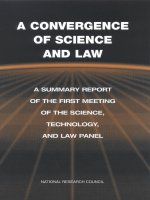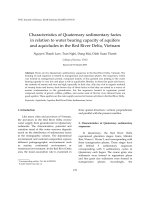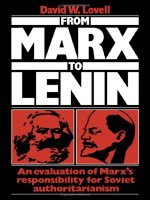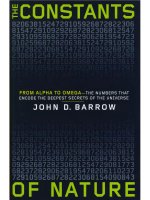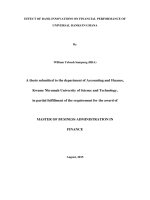From certainty to uncertainty the story of science and ideas in the 20th century
Bạn đang xem bản rút gọn của tài liệu. Xem và tải ngay bản đầy đủ của tài liệu tại đây (3.78 MB, 247 trang )
Also by F. David Peat
Blackfoot Physics: A Journey into the Native American Universe
Seven Life Lessons of Chaos: Timeless Wisdom from the Science of Change (with
John Briggs)
The Blackwinged Night: Creativity in Nature and Mind
Science, Order, and Creativity (with David Bohm)
Infinite Potential: The Life and Times of David Bohm
In Search of Nikola Tesla
Who’s Afraid of Schrödinger’s Cat? An A-to-Z Guide to All the New Science Ideas
You Need to Keep Up with the New Thinking (with Ian Marshall and Danah
Zohar)
Glimpsing Reality: Ideas in Physics and the Link to Biology (edited, with Paul
Buckley)
The Philosopher’s Stone: Chaos, Synchronicity, and the Hidden Order of the World
Quantum Implications: Essays in Honour of David Bohm (edited, with Basil Hiley)
Einstein’s Moon: Bell’s Theorem and the Curious Quest for Quantum Reality
Superstrings and the Search for the Theory of Everything
Turbulent Mirror: An Illustrated Guide to Chaos Theory and the Science of
Wholeness (with John Briggs)
Cold Fusion: The Making of a Scientific Controversy
Artificial Intelligence: How Machines Think
Synchronicity: The Bridge Between Matter and Mind
Looking Glass Universe: The Emerging Science of Wholeness (with John Briggs)
The Armchair Guide to Murder and Detection
The Nuclear Book
The Story of Science and Ideas
in the Twentieth Century
F. DAVID PEAT
JOSEPH HENRY PRESS
WASHINGTON, D.C.
Joseph Henry Press • 2101 Constitution Avenue, N.W. • Washington, D.C. 20418
The Joseph Henry Press, an imprint of the National Academy Press, was created
with the goal of making books on science, technology, and health more widely
available to professionals and the public. Joseph Henry was one of the founders
of the National Academy of Sciences and a leader in early American science.
Any opinions, findings, conclusions, or recommendations expressed in this
volume are those of the author and do not necessarily reflect the views of the
National Academy of Sciences or its affiliated institutions.
Library of Congress Cataloging-in-Publication Data
Peat, F. David, 1938-
From certainty to uncertainty : the story of science and ideas in the
twentieth century / F. David Peat.
p. cm.
Includes index.
ISBN 0-309-07641-2 (hard)
1. Physics—Philosophy. 2. Certainty. 3. Chaotic behavior in
systems. 4. Physics—History—20th century. I. Title: Story of science
and ideas in the twentieth century. II. Title.
QC6 .P33 2002
530′.09′04—dc21
2002001482
Cover art: Diego Rodriguez Velazquez, Las Meninas (detail), copyright Erich
Lessing/Art Resource, NY (left side); Michele de la Menardiere, Homage to Las
Meninas (right side).
Copyright 2002 by F. David Peat. All rights reserved.
Printed in the United States of America.
For Alessandro
vii
Preface ix
1 Quantum Uncertainty 1
2 On Incompleteness 27
3 From Object to Process 52
4 Language 71
5 The End of Representation 90
6 From Clockwork to Chaos 115
7 Re-envisioning the Planet 154
8 Pausing the Cosmos 187
Postscript 215
Appendix: Gödel’s Theorem 217
Index 223
CONTENTS
PREFACE
The first year of a new century
always appears auspicious. The year 1900 was no exception. Americans
welcomed it in with the three Ps: Peace, Prosperity, and Progress. It was
the culmination of many outstanding achievements and looked for-
ward, with great confidence, to a century of continued progress. The
twentieth century would be an age of knowledge and certainty. Ironi-
cally it ended in uncertainty, ambiguity, and doubt. This book is the
story of that change and of a major transformation in human think-
ing. It also argues that, while our new millennium may no longer offer
certainty, it does hold a new potential for growth, change, discovery,
and creativity in all walks of life.
On April 27, 1900, Lord Kelvin, the eminent physicist and presi-
dent of Britain’s Royal Society, addressed the Royal Institution, point-
ing out “the beauty and clearness of the dynamical theory.” Finally
Newton’s physics had been extended to embrace all of physics, includ-
ing both heat and light. In essence, everything that could be known
was, in principle at least, already known. The president could look
ahead to a new century with total conviction. Newton’s theory of
ix
Que sais-je? (What do I know?) Montaigne
x Preface
motion had been confirmed by generations of scientists, and it ex-
plained everything from the orbits of the planets to the times of the
tides, the fall of an apple, and the path of a projectile. What’s more,
during the preceding decades James Clerk Maxwell had established a
definitive theory of light. Taken together, Newton’s and Maxwell’s two
theories appeared to be capable of explaining every phenomenon in
the entire physical universe.
Yet the cusp of the twentieth century presents us with an irony.
1900 was a year of great stability and confidence. It saw the consolida-
tion and summing up of many triumphs in science, technology, engi-
neering, economics, and diplomacy. As Senator Chauncey Depew of
New York put it, “There is not a man here who does not feel 400 per-
cent bigger in 1900 than he did in 1896, bigger intellectually, bigger
hopefully, bigger patriotically,” while the Reverend Newell Dwight
Hillis claimed, “Laws are becoming more just, rules more humane;
music is becoming sweeter and books wiser.” Yet, at that very moment
other thinkers, inventors, scientists, artists, and dreamers, including
Max Planck, Henri Poincaré, Thomas Edison, Guglielmo Marconi,
Nikola Tesla, the Wright brothers, Bertrand Russell, Paul Cézanne,
Pablo Picasso, Marcel Proust, Sigmund Freud, Henry Ford, and
Herman Hollerith were conceiving of ideas and inventions that were
to transform the entire globe.
1900 was the year in which flash photography was invented and
speech was first transmitted by radio. Arthur Evans discovered evi-
dence of a Minoan culture and the United States backed its paper cur-
rency with gold. Once the Gold Standard had been adopted, was there
anything that could stand in the way of a greater degree of confidence
in the future of their world?
1900 also represents the culmination of a period of rapid discov-
ery. In the two previous years the Curies had discovered radium and
J. J. Thomson the electron. Von Linde had liquefied air and Aspirin had
been invented. Edison’s Vitascope together with the magnetic record-
ing of sound heralded the age of the movies.
Thanks to Nikola Tesla’s inventions in alternating current, the city
of Buffalo was receiving electrical power generated by Niagara Falls.
Count von Zeppelin constructed an airship, the Paris Metro opened,
Preface xi
and London saw its first motorbus. By 1902, the transmission of data
by telephone and telegraph was already well established, and the first
faxed photographs were being transmitted.
1900 also saw a link between Britain’s Trades Union Congress and
the Independent Labour Party, a move that would eventually lead to
the establishment of the welfare state. With such a dream of social im-
provement people seemed justified in believing that the future would
provide better housing, education, and health services. Homelessness
would be a thing of the past and, while those thrown out of work would
need to tighten their belts a little, they would be supported by the wel-
fare state and would no longer face suffering and hardship.
Europe also experienced a great sense of stability in 1900. Queen
Victoria, who had ruled since 1837, was still on the throne. She had
become known as “the Grandmother of Europe,” since her grandchil-
dren were now part of the European monarchy. Indeed all of the Euro-
pean kings and queens, as well as the Russian royal family, were a part
of a single international family presided over by Victoria. It was for this
reason, diplomats believed, there would never be a war within Europe.
On May 18, 1899, at the prompting of Czar Nicholas II’s minister
of foreign affairs, 26 nations met at The Hague for the world’s first
peace conference. There they established an International Court to ar-
bitrate in disputes between nations. The conference outlawed poison
gases, dumdum bullets, and the discharge of bombs from balloons.
Wars and international conflicts would be things of the past. The world
itself was moving toward a new golden age in which science and tech-
nology would be put to the service of humanity and world peace
Yet when people look to a golden future they should not forget the
role of hubris. Often our predictions return to haunt us. It is particu-
larly ironic that in this same year, 1900, ideas and approaches began to
surface that were to transform our world, our society, and ourselves in
radical and unpredictable ways.
What were those tiny seeds that were destined to blossom in such
unexpected directions? In 1900 Max Planck published his first paper
on the quantum, and young Albert Einstein graduated from the Zurich
Polytechnic Academy. A year later Werner Heisenberg was born. These
three physicists would create the great revolutions of modern science.
xii Preface
In 1900 Henri Poincaré was working on an abstruse technical diffi-
culty involving Newtonian mechanics. Over half a century later this
would explode into chaos theory. Astronomers were looking forward
to the opening of the great telescopes at Mount Wilson in 1904 and, in
the decades that followed, Edwin Hubble would use these instruments
to discover that the universe was far vaster than ever believed and,
moreover, that it was continually expanding.
In 1900 biologists rediscovered the work of an obscure mid nine-
teenth century monk, Gregor Mendel. Ignored by the scientific com-
munity in his own day, Mendel had examined the way physical charac-
teristics are inherited when different varieties of garden peas are
crossed. Who would have guessed that exactly a century after this re-
discovery of the basis of genetic inheritance, the completion of the
Human Genome Project would be announced?
This same year, 1900, saw the publication of Sigmund Freud’s In-
terpretation of Dreams. Much more rational than a Victorian dream
book, which typically flirted with divination and the occult, it demon-
strated that dreams are “the royal road to the unconscious” and, in
turn, that our waking lives are ruled by the irrationality of the uncon-
scious. That unconscious had a potential for violence and human irra-
tionality that was to be powerfully demonstrated again and again dur-
ing the twentieth century.
At the end of the nineteenth century Percival Lowell used his for-
tune to establish his own observatory at Flagstaff, Arizona, with the
aim of discovering life on Mars. In 1900 H. G. Wells, inspired by these
ideas, published War of the Worlds, with its image of the mass destruc-
tion of the human race. Ironically the real possibility of global destruc-
tion in the twentieth century did not arise from little green men from
Mars but from human-made weapons of mass destruction.
1900 was the year when the young philosopher Bertrand Russell
heard Giuseppe Peano speak at a conference in Paris. The lecture so
inspired Russell that he devoted his life’s work to the discovery of cer-
tainty in mathematics and philosophy. How this mathematical Holy
Grail itself was eventually subverted forms the core of Chapter 2.
In 1900, inspired by the writings of John Ruskin, Marcel Proust
visited Venice. He abandoned the novel on which he had been working
Preface xiii
and, determined to seek some new way of expressing “man’s” confron-
tation with eternity, he embarked on a master plan that was to termi-
nate in one of the major literary works of the twentieth century. It was
also the year that the 18-year-old James Joyce, after having his first
article published, decided to become a full-time writer. In this same
year Picasso had his first exhibition and made a trip to Paris, an event
that was to have a profound effect on art in the twentieth century. 1900
was also the year in which Paul Cézanne was working on his famous
studies of Montagne Sainte-Victoire. The works he produced there had
a revolutionary effect on painting and produced yet another form of
doubt as he questioned the certainty of what he was seeing.
In the previous year Henry Ford had formed the Detroit Motor
Company, which would produce the famous Model T, a car that trans-
formed American society. Add to this Ford’s discovery of mass produc-
tion through the assembly line and one understands in part why, when
young Henry left his father’s farm, only a quarter of Americans lived in
a city, yet, when he died, well over half of them were city dwellers. In
1900 there were 8,000 automobiles in the United States and 150 miles
of paved road. Today the number of cars in the United States is close to
100 million.
A few years earlier, in 1896, Herman Hollerith had created the
Tabulating Machine Company to speed up the processing of data us-
ing a system of punched cards. In 1911 the company’s name changed
to International Business Machines. The radio vacuum tube had been
invented (in 1904), and so both the physical components and the busi-
ness infrastructure were already in place for the creation of the com-
puter revolution.
In the same year as the creation of Hollerith’s Tabulating Machine
Company, Henri Becquerel discovered the radioactivity of uranium. A
few decades later, while studying Becquerel’s phenomenon, the Ger-
man scientist Otto Hahn realized that the atom could be split. When
knowledge of this process reached the United States, colleagues per-
suaded Einstein to write a letter to President Roosevelt recommending
the building of an atomic bomb, out of the fear that Nazi scientists
would do so first. And so was born the atomic age, and with it the
possibility of the annihilation of all life on earth.
xiv Preface
While the twentieth century began with confident certainty it
ended in unsettling uncertainty. Never again will we have the same
degree of pride in our knowledge. In our infatuation with science and
technology we overestimated our ability to manipulate and control the
world around us. We forgot the power of the mind’s irrational im-
pulses. We were too proud in our intellectual achievements, too confi-
dent in our abilities, too convinced that humans would stride across
the world like gods.
Today we are wiser and more cautious. We are suspicious of great
plans and global promises. We view with caution the sweeping propos-
als of experts and politicians. We savor unbounded optimism with a
generous pinch of salt.
Above all we want a better world for ourselves, our children, and
our children’s children. We have learned that ordinary people can have
a voice. We will not put our lives blindly into the hands of politicians
and institutions. We demand to be heard and we know we can be effec-
tive.
Now let us return in more detail to the twentieth century and dis-
cover the various ways in which certainty dissolved into uncertainty.
Each chapter that follows tells us something about uncertainty in the
worlds of art, science, economics, society, and the environment. Each
adds another layer to those increasingly complex questions: Who am I?
What do I know? What does it mean to be human?
FDP
Pari, Italy
2002
1
One
QUANTUM UNCERTAINTY
In 1900 Lord Kelvin spoke of the
triumphs of physics and how Newton’s theory of motion could be ex-
tended to embrace the phenomena of light and heat. His address went
on to mention “two clouds” that obscured the “beauty and clearness”
of the theory: the first involved the way light travels through space, the
second was the problem of distributing energy equally among vibrat-
ing molecules. The solution Kelvin proposed, however, proved to be
way off the mark. Ironically, what Kelvin had taken to be clouds on the
horizon were in fact two bombshells about to create a massive explo-
sion in twentieth century physics. Their names were relativity and
quantum theory, and both theories had something to say about light.
Light, according to physicists like Kelvin, is a vibration, and like
every other vibration it should be treated by Newton’s laws of motion.
But a vibration, physicists argued, has to be vibrating in something.
And so physicists proposed that space is not empty but filled with a
curious jelly called “the luminiferous ether.” But this meant that the
speed of light measured in laboratories on earth—the speed with
2 From Certainty to Uncertainty
which vibrations appear to travel through the ether—should depend
on how fast and in what direction the earth is moving through the
ether. Because the earth revolves around the sun this direction is al-
ways varying, and so the speed of light measured from a given direc-
tion should vary according to the time of year. Scientists therefore ex-
pected to detect a variation in the speed of light measured at various
times of the year, but very accurate experiments showed that this was
not the case. No matter how the earth moves with respect to the back-
ground of distant stars, the speed of light remains the same.
This mystery of the speed of light and the existence, or nonexist-
ence, of the ether was only solved with Einstein’s special theory of rela-
tivity, which showed that the speed of light is a constant, independent
of how fast you or the light source is traveling.
The other cloud on Kelvin’s horizon, the way in which energy is
shared by vibrating molecules, was related to yet another difficult prob-
lem—the radiation emitted from a hot body. In this case the solution
demanded a revolution in thinking that was just as radical as relativity
theory—the quantum theory.
Bohr and Einstein
Special relativity was conceived by a single mind—that of Albert
Einstein. Quantum theory, however, was the product of a group of
physicists who largely worked together and acknowledged the Danish
physicist Niels Bohr as their philosophical leader. As it turns out, the
tensions between certainty and uncertainty that form the core of this
book are nowhere better illustrated than in the positions on quantum
theory taken by these two great icons of twentieth century physics,
Einstein and Bohr. By following their intellectual paths we are able to
discover the essence of this great rupture between certainty and uncer-
tainty.
When the two men debated together during the early decades of
the twentieth century they did so with such passion for truth that
Einstein said that he felt love for Bohr. However, as the two men aged,
the differences between their respective positions became insurmount-
Quantum Uncertainty 3
able to the point where they had little to say to each other. The Ameri-
can physicist David Bohm related the story of Bohr’s visit to Princeton
after World War II. On that occasion the physicist Eugene Wigner ar-
ranged a reception for Bohr that would also be attended by Einstein.
During the reception Einstein and his students stood at one end of the
room and Bohr and his colleagues at the other.
How did this split come about? Why, with their shared passion for
seeking truth, had the spirit of open communication broken down be-
tween the two men? The answer encapsulates much of the history of
twentieth century physics and concerns the essential dislocation be-
tween certainty and uncertainty. The break between them involves one
of the deepest principles of science and philosophy—the underlying
nature of reality. To understand how this happened is to confront one
of the great transformations in our understanding of the world, a leap
far more revolutionary than anything Copernicus, Galileo, or Newton
produced. To find out how this came about we must first take a tour
through twentieth century physics.
Relativity
Einstein’s name is popularly associated with the idea that “everything
is relative.” This word “relative” has today become loaded with a vast
number of different associations. Sociologists, for example, speak of
“cultural relativism,” suggesting that what we take for “reality” is to a
large extent a social construct and that other societies construct their
realities in other ways. Thus, they argue, “Western science” can never
be a totally objective account of the world for it is embedded within all
manner of cultural assumptions. Some suggest that science is just one
of the many equally valid stories a society tells itself to give authority to
its structure; religion being another.
In this usage of the words “relative” and “relativism” we have come
far from what Einstein originally intended. Einstein’s theory certainly
tells us that the world appears different to observers moving at differ-
ent speeds, or who are in different gravitational fields. For example,
relative to one observer lengths will contract, clocks will run at differ-
4 From Certainty to Uncertainty
ent speeds, and circular objects will appear ellipsoidal. Yet this does not
mean that the world itself is purely subjective. Laws of nature underlie
relative appearances, and these laws are the same for all observers no
matter how fast they are moving or where they are placed in the uni-
verse. Einstein firmly believed in a totally objective reality to the world
and, as we shall see, it is at this point that Einstein parts company with
Bohr.
Perhaps a note of clarification should be added here since that
word “relativity” covers two theories. In 1905, Einstein (in what was to
become known as the special theory of relativity) dealt with the issue
of how phenomena appear different to observers moving at different
speeds. He also showed that there is no absolute frame of reference in
the universe against which all speeds can be measured. All one can talk
about is the speed of one observer when measured relative to another.
Hence the term “relativity.”
Three years later the mathematician Herman Minkowski ad-
dressed the 80th assembly of German National Scientists and Physi-
cians at Cologne. His talk opened with the famous words: “Henceforth
space by itself, and time by itself, are doomed to fade away into mere
shadows, and only a kind of union of the two will preserve an indepen-
dent reality.” In other words, Einstein’s special theory of relativity im-
plied that space and time were to be unified into a new four-dimen-
sional background called space-time.
Einstein now began to ponder how the force of gravity would en-
ter into his scheme. The result, published in 1916, was his general
theory of relativity (his earlier theory now being a special case that
applies in the absence of gravitational fields). The general theory
showed how matter and energy act on the structure of space-time and
cause it to curve. In turn, when a body enters a region of curved space-
time its speed begins to change. Place an apple in a region of space-
time and it accelerates, just like an apple that falls from a tree on earth.
Seen from the perspective of General Relativity the force of gravity
acting on this apple is none other than the effect of a body moving
through curved space-time. The curvature of this space-time is pro-
duced by the mass of the earth.
Now let us return to the issue of objectivity in a relative world.
Quantum Uncertainty 5
Imagine a group of scientists here on earth, another group of scientists
in a laboratory that is moving close to the speed of light, and a third
group located close to a black hole. Each group observes and measures
different phenomena and different appearances, yet the underlying
laws they deduce about the universe will be identical in each of the
three cases. For Einstein, these laws are totally independent of the state
of the observer.
This is the deeper meaning of Einstein’s great discovery. Behind all
phenomena are laws of nature, and the form of these laws, their most
elegant mathematical expression, is totally independent of any ob-
server. Phenomena, on the other hand, are manifestations of these un-
derlying laws but only under particular circumstances and contexts.
Thus, while phenomena appear different for different observers, the
theory of relativity allows scientists to translate, or transform, one phe-
nomenon into another and thus to return to an objective account of
the world. Hence, for Einstein the certainty of a single reality lies be-
hind the multiplicity of appearance.
Relativity is a little like moving between different countries and
changing money from dollars into pounds, francs, yen, or euros. Ig-
noring bank charges, the amount of money is exactly the same, only its
physical appearance—the bank notes in green dollars or pounds, yen,
euros, and so on changes. Similarly a statement made at the United
Nations is simultaneously translated into many different languages. In
each particular case the sound of the statement is quite different but
the underlying meaning is the same. Observed phenomena could be
equated to statements in different languages, but the underlying mean-
ing that is the source of these various translations corresponds to the
objective laws of nature.
This underlying reality is quite independent of any particular ob-
server. Einstein felt that if the cosmos did not work in such a way it
would simply not make any sense and he would give up doing physics.
So, in spite of that word “relativity,” for Einstein there was a concrete
certainty about the world, and this certainty lay in the mathematical
laws of nature. It is on this most fundamental point that Bohr parted
company with him.
6 From Certainty to Uncertainty
Blackbody Radiation
If Einstein stood for an objective and independent reality what was
Niels Bohr’s position? Bohr was an extremely subtle thinker and his
writings on quantum theory are often misunderstood, even by profes-
sional physicists! To discover how his views on uncertainty and ambi-
guity evolved we must go back to 1900, to Kelvin’s problem of how
energy is distributed amongst molecules and an even more troubling,
related issue, that of blackbody radiation.
A flower, a dress, or a painting is colored because it absorbs light at
certain frequencies while reflecting back other frequencies. A pure
black surface, however, absorbs all light that falls on it. It has no prefer-
ence for one color over another or for one frequency over another.
Likewise, when that black surface is warmer than its surroundings it
radiates its energy away and, being black, does so at every possible fre-
quency without preferring one frequency (or color) over another.
When physicists in the late nineteenth century used their theories
to calculate how much energy is being radiated, the amount they ar-
rived at, absurdly, was infinite. Clearly this was a mistake, but no one
could discover the flaw in the underlying theory.
Earlier that century the Scottish physicist James Clerk Maxwell had
pictured light in the form of waves. Physicists knew how to make cal-
culations for waves in the ocean, sound waves in a concert hall, and the
waves formed when you flick a rope that is held fixed at the other end.
Waves can be of any length, with an infinite range of gradations. In the
case of sound, for example, the shorter the wavelength—the distance
between one crest and the next—the higher the pitch, or frequency, of
the sound because the shorter the distance between wave crests, the
more crests pass a particular point, such as your ear, in a given length
of time. The same is true of light: long wavelengths lie toward the red
end of the spectrum, whereas blue light is produced by higher frequen-
cies and shorter wavelengths.
By analogy with sound and water waves, the waves of light radi-
ated from a hot body were assumed to have every possible length and
every possible frequency; in other words, light had an infinite number
Quantum Uncertainty 7
of gradations from one wavelength to the next. In this way an infinity
crept into the calculation and emerged as an infinite amount of energy
being radiated.
The Quantum
In 1900 Max Planck discovered the solution to this problem. He pro-
posed that all possible frequencies and wavelengths are not permitted,
because light energy is emitted only in discrete amounts called quanta.
Rather than continuous radiation emerging from a hot body, there is a
discontinuous, and finite, emission of a series of quanta.
With one stroke the problem of blackbody radiation was solved,
and the door was opened to a whole new field that eventually became
know as quantum theory. Ironically Einstein was the first scientist to
apply Planck’s ideas. He argued that if light energy comes in the form
of little packages, or quanta, then when light falls on the surface of a
metal it is like a hail of tiny bullets that knock electrons out of the
metal. In fact this is exactly what is observed in the “photoelectric ef-
fect,” the principle behind such technological marvels as the “magic
eye.” When you stand in the doorway of an elevator you interrupt a
beam of light that is supposed to be hitting a photocell. This beam
consists of light quanta, or photons, that knock electrons from their
atoms and in this way create an electrical current that activates a relay
to close the door. A person standing in the doorway interrupts this
beam and so the door does not close.
The next important step in the development of quantum theory
came in 1913 from the young Niels Bohr who suggested that not only
light, but also the energy of atoms, is quantized. This explains why,
when atoms emit or lose their energy in the form of radiation, the
energy given out by a heated atom is not continuous but consists of a
series of discrete frequencies that show up as discrete lines in that
atom’s spectrum. Along with contributions from Werner Heisenberg,
Max Born, Erwin Schrödinger and several other physicists the quan-
tum theory was set in place. And with it uncertainty entered the heart
of physics.
8 From Certainty to Uncertainty
Complementarity
Just as relativity taught that clocks can run at different rates, lengths
can contract, and twins on different journeys age at different rates, so
too quantum theory brought with it a number of curious and bizarre
new concepts. One is called wave-particle duality. In some situations
an electron can only be understood if it is behaving like a wave delocal-
ized over all space. In other situations an electron is detected as a par-
ticle confined within a tiny region of space. But how can something be
everywhere and at the same time also be located at a unique point in
space?
Niels Bohr elevated duality to a universal principle he termed
“complementarity.” A single description “this is a wave” or “this is a
particle,” he argued, is never enough to exhaust the richness of a quan-
tum system. Quantum systems demand the overlapping of several
complementary descriptions that when taken together appear para-
doxical and even contradictory. Quantum theory was opening the door
to a new type of logic about the world.
Bohr believed that complementarity was far more general than just
a description of the nature of electrons. Complementarity, he felt, was
basic to human consciousness and to the way the mind works. Until
the twentieth century, science had dealt in the certainties of Aristote-
lian logic: “A thing is either A or not-A.” Now it was entering a world in
which something can be “both A and not-A.” Rather than creating ex-
haustive descriptions of the world or drawing a single map that corre-
sponds in all its features to the external world, science was having to
produce a series of maps showing different features, maps that never
quite overlap.
Chance and the Irrational in Nature
If complementarity shook our naive belief in the uniqueness of scien-
tific physical objects, certainty was to receive yet another shock in the
form of the new role taken by chance. Think, for example, of Marie
Curie’s discovery of radium. This element is radioactive, which means
